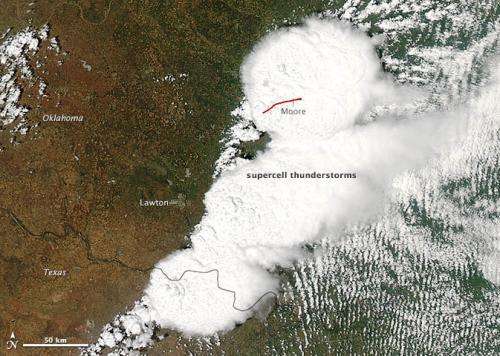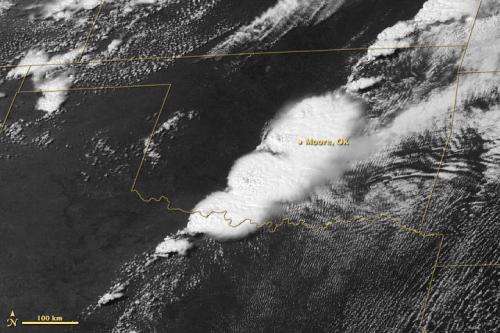Satellites see storm system that created Moore, Okla., tornado

On May 20, 2013, NASA and NOAA satellites observed the system that generated severe weather in the south central United States and spawned the Moore, Okla., tornado.
The tornado that struck Moore on the afternoon of Monday, May 20, was an F-4 tornado on the enhanced Fujita scale, according to the National Weather Service. F-4 tornadoes have sustained winds from 166 to 200 mph. This tornado was about twice as wide as the tornado that struck Moore on May 3, 1999. Moore is located 10 miles south of Oklahoma City.
Before, during and after the tornado, satellites provided imagery and data to forecasters. The first tornado warning was issued around 2:40 p.m. CDT (local time). By 3:01 p.m. CDT a tornado emergency was issued for Moore, and 35 minutes later at 3:36 p.m. CDT, the tornado spun down and dissipated.
NASA's Aqua satellite captured a visible-light image that provided a detailed look at the supercell thunderstorm. NOAA's GOES-13 satellite provided continuously updated satellite imagery depicting the storm's movement. After the tornado, the NASA-NOAA Suomi National Polar-orbiting Partnership satellite's lightning observations showed that the thunderstorm complex was still active after nightfall.
NOAA's GOES-13 satellite provided forecasters with images of the storm system every 15 minutes. One GOES-13 satellite image was captured at 19:55 UTC (2:55 p.m. CDT) as the tornado began its deadly swath. The tornado was generated near the bottom of a line of clouds resembling an exclamation mark. The GOES-13 satellite imagery from the entire day was assembled into an animation by the NASA GOES Project at NASA's Goddard Space Flight Center in Greenbelt, Md.

Four minutes after the tornado dissipated (19:40 UTC / 3:40 p.m. EDT), the Moderate Resolution Imaging Spectroradiometer (MODIS) instrument aboard NASA's Aqua satellite captured a visible image of the supercell thunderstorm that spawned the Moore tornado. That image was created by the NASA Goddard MODIS Rapid Response Team and Adam Voiland, NASA Earth Observatory.
Later as the storm system continued through the region, another satellite captured an image of the storm at night that showed it was still powerful. The Visible Infrared Imaging Radiometer Suite aboard Suomi NPP observed lightning in a nighttime image on May 21 at 07:27 UTC (3:27 a.m. EDT). Lightning appeared as rectangular shapes in the image. The VIIRS imagery showed the city lights in the Oklahoma City area, but there was reduced light output in Moore as a result of tornado damage.
The Suomi NPP satellite carries an instrument so sensitive to low light levels that it can detect lightning in the middle of the night. The Day/Night band on Suomi NPP produces nighttime visible imagery using illumination from natural (the moon, forest fires) and man-made sources (city lights). The data were captured by the direct broadcast antenna at University of Wisconsin.
Provided by NASA's Goddard Space Flight Center



















